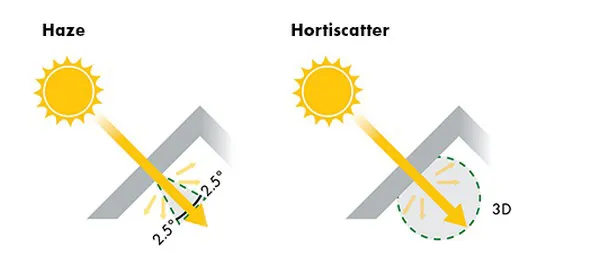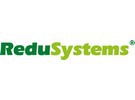The level of light diffusion caused by diffuse coatings and glass is commonly known as Haze in the market. However, the term Hortiscatter provides more information about how the light is diffused.
The use of the term Haze in greenhouse cultivation originated with the first trials with diffuse light. But this term was never actually intended for glass. It comes from the American ASTM-1003 test method which was designed for plastics and indicates the transparency of those plastics. For materials with a Haze greater than 30%, however, this test method is no longer usable. In other words: it does not properly express the light diffusion. Particularly not for glass.
With no alternative available, the term Haze became commonplace in greenhouse cultivation. Haze indicates a percentage of light that is scattered more than 2.5° from the incoming angle. In case of 60% Haze, 60% of the incoming light is scattered more than 2.5° from the incoming angle of incidence. This percentage does not provide enough information about the light diffusion, but because most suppliers use the same measuring equipment, the Haze-gard, it was generally understood in the market.
Over time, however, criticisms began to be voiced by growers, particularly with respect to diffuse glass.
Hortiscatter
When the NEN2675 standard was updated, Haze was replaced by Hortiscatter. Although the updated standard has now been in use for nearly two years, the term Haze still persists.
Like Haze, Hortiscatter is expressed as a percentage between 0 and 100%. Clear glass has a Hortiscatter of 0%, while a material that evenly scatters incoming light over all angles has a Hortiscatter of 100%. Both diffuse coating and diffuse glass can be characterised with the Hortiscatter.

Diffuse coatings
The Hortiscatter of ReduFuse and ReduFuse IR depends on the thickness of the coating, which in turn depends on the number of buckets applied per hectare. The level of light diffusion by both coatings and diffuse glass expressed in Hortiscatter is generally lower than the Haze value. It is even possible for a Haze of 70% to coexist with a Hortiscatter of 40%, but usually the values are closer together.
Whatever the case: the higher the Hortiscatter, the better the diffusion of the light in the crop. And that reduces stress, promotes more even growth, better production and higher quality.
For more information: ReduSystems
ReduSystems
+31(0)13 507 53 99
sales@redusystems.com
www.redusystems.com
